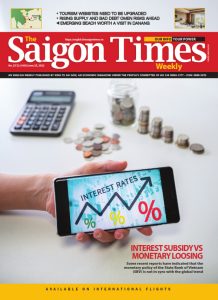Some recent reports have indicated that the monetary policy of the State Bank of Vietnam (SBV) is not in sync with the global trend.
While many countries are raising interest rates and tightening the monetary policy to control inflation, it is said that the SBV has been loosening its monetary policy by launching a package of interest subsidy at two percentage points. In addition, efforts to step up public investment also signal a loose monetary policy.
The two points above, in fact, are incorrect, or far from well-grounded.
For the point that the interest rate subsidy of two percentage points equates the expansionary monetary policy, this argument is only logical if the SBV increases money supply. The higher money supply is meant to cover the subsidized interest sum corresponding to the amount of credits granted by banks under this scheme on one hand, and to recapitalize banks involved in this program on the other hand.
In reality, however, the sum to cover the subsidy is sourced from the State budget capped at VND40 trillion. In other words, the SBV is not told to earmark VND40 trillion for the scheme, as it is entrusted to the State Treasury.
Budget expenditures, including public investment, are not covered by the SBV, so the central bank’s money supply, at length, is not altered due to the interest subsidy scheme. Therefore, the SBV’s involvement in the scheme does not result in loosening the monetary policy.
 Regarding the SBV recapitalizing commercial banks to assist them in lending under the subsidy scheme, this is just an option for the SBV, not a mandate. If the SBV finds that money supply has reached a certain limit that can exert pressure on inflation, the central bank will not recapitalize banks, but ask them to downsize credits for businesses not in the list of priority sectors. As such, the credit growth caps for commercial banks will not be changed, and thus the central bank’s money supply. In other words, the SBV’s involvement in the interest subsidy scheme does not translate into nor relate to any loose monetary policy.
Regarding the SBV recapitalizing commercial banks to assist them in lending under the subsidy scheme, this is just an option for the SBV, not a mandate. If the SBV finds that money supply has reached a certain limit that can exert pressure on inflation, the central bank will not recapitalize banks, but ask them to downsize credits for businesses not in the list of priority sectors. As such, the credit growth caps for commercial banks will not be changed, and thus the central bank’s money supply. In other words, the SBV’s involvement in the interest subsidy scheme does not translate into nor relate to any loose monetary policy.
Regarding public investment, this is currently perceived as monetary loosening. As explained early on, allocations for public investment come from the State budget whose revenues include taxes, fees and payments by State enterprises. Under certain special circumstances, the central bank may lend to the State budget, but such circumstances are rare (and are not allowed in many countries). Normally, if the central bank lends to the State budget, it can only do so in an indirect manner by spurring money supply so that commercial banks can buy treasury notes (in a way without pushing up the note’s yield). Or the central bank in an exception case can directly buy the government bond, which is referred to as quantitative easing in the U.S.
Under the current situation in Vietnam, especially regarding the stimulus package of VND350 trillion, whether the SBV increases money supply to underpin the State budget or not is just a policy option by the central bank. If the SBV finds that the increased money supply will push up inflation, and if the SBV aligns itself with many other central banks in the world that fighting inflation requires raising interest rates, then it will not spur money supply. Therefore, increasing public investment and public expenditures in this case does not mean easing the monetary policy.
It is noted that the misunder-standing mentioned above (on the correlation between public investment and loose monetary policy) has been seen not only in Vietnam but in the U.S. as well. Many people in Vietnam have criticized the U.S. Secretary of the Treasury as “absurd” when she asserted that the spending package of US$1.75 trillion approved by President Joe Biden in October 2021 helped pull down inflation. Their common reasoning is that higher expenditures by the U.S. Government fueled inflation rather than pulling it down.
As stated early on, public spending is one issue, and the central bank increasing money supply is another, and therefore, whether increasing public spending will fire up inflation is another different issue. Even in the U.S., although public expenditures have shot up sharply, the Federal Reserve has tightened its monetary policy by hiking interest rates and narrowing down quantitative easing to control inflation. Therefore, inflation stateside will return to the normal level. So is the case in Vietnam.











